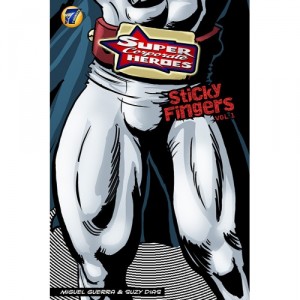 Superheroes as a form of celebrity culture isn’t a new thing. Many examples come to mind: DC’s Booster Gold, Mark Waids Insufferable, each dealing with the other side of being a superhero – making money. But neither title really tackles the corporate culture head on – well not like Super Corporate Heroes. It asks a completely new question: what if superheroes were on a payroll, and would only save you if you paid up? Miguel Guerra and Suzy Dias provide this take on the superhero culture, and while it falls victim to some minor flaws, it becomes something fairly unique to the genre.
Superheroes as a form of celebrity culture isn’t a new thing. Many examples come to mind: DC’s Booster Gold, Mark Waids Insufferable, each dealing with the other side of being a superhero – making money. But neither title really tackles the corporate culture head on – well not like Super Corporate Heroes. It asks a completely new question: what if superheroes were on a payroll, and would only save you if you paid up? Miguel Guerra and Suzy Dias provide this take on the superhero culture, and while it falls victim to some minor flaws, it becomes something fairly unique to the genre.
As mentioned before, Super Corporate Heroes follows a group of superheroes under the payroll of Superhero Inc. These are men and woman who don’t do it for the altruism – this is for fame and fortune. The series follows the day to day lives of these heroes – the sleazy, arrogant American Icon, the woman of steel Ms.Titanium, the somewhat anatomically correct human spider known as Spinlar – each of these heroes fulfill an archetype from many of the big two publishers’ rosters. While at times they are amusing parodies, like Spinlar ,who spins his web from his back side, other times they can be quite blatant, like the Wolverine-esque Meerkat, and the less than subtle references become more of a distraction than bringing anything to the table. Despite this, Guerra and Dias manage to create a well-rounded cast of characters that at times elevate things higher than simple parody.
Where this comic really shines is the situations these characters are placed in. While at times the moment-to-moment dialogue feels uneven, jumping from 1960s hammy to more modern characterisation, the events that take place are often a treat. From the victim of a mugging who is torn between being mugged (which is cheaper) or paying up to the local hero to save him, to the disgust a bank has toward being saved by Spinlar, the moments can be incredibly amusing to see play out.
At times the themes move on from simple satire, to deeper exploration of economics in our society. Questions of equal pay between male heroes and female heroes, lack of funding to more basic emergency services, and small businesses unable to pay insurance are all brought up. It’s a welcome depth to the idea of a corporate culture and superheroes, and while these really only get touched on briefly, it’d be great to see more of these topics dealt with as the miniseries moves on.
The art on the other hand is a mixed bag. While it certainly invokes strong ties to the square-jawed, simply designed heroes of the Silver Age, the detail in the facial features appears a bit off. Faces seem to be oddly placed, and occasionally characters are contorted in such a way that looks weird. Backgrounds are also lacking, keeping to a bare minimum of detail, and never really giving the comic a sense of place outside of generic city-scapes. The art overall isn’t bad, but it never becomes anything more than a fairly simply drawn book.
Super Corporate Heroes surprised me, and that doesn’t happen too much these days. Its relevant satire of the global economy elevates it higher than many other comics in its genre, to create something that both entertains and intrigues more than you’d think.

 RSS - Posts
RSS - Posts
Recent Comments